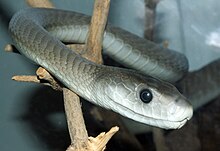|
Invertebrates[edit]
Arthropods[edit]
Arachnids[edit]
Further information: Arachnidism and List of medically significant spider bites
Strictly speaking, all spiders and scorpions possess venom, though only a handful are dangerous to humans. Spiders typically deliver their venom with a bite from piercing, fang-like chelicerae; scorpions sting their victims with a long, curved stinger mounted on the telson.
Spiders[edit]

Latrodectus mactans, one of several venomous North American black widows
Scorpions[edit]
Of more than a thousand known species of scorpion, only a few dozen have venom that is dangerous to humans,[6] most notably the bark scorpions, including:
Insects[edit]
Further information: Insect bites and stings and List of biting or stinging arthropods
Other arthropods[edit]
Mollusks[edit]
- Cone snails of the family Conidae are a diverse group of predatory marine gastropods, mostly tropical in distribution, which hunt and immobilize prey using a modified harpoon-like radular tooth that can deliver neurotoxic conopeptides. All cone snails are venomous, though the danger posed to humans varies widely by species.
Many species of octopus, squid, and cuttlefish make use of venom when hunting their prey.
- The blue-ringed octopodes (Hapalochlaena spp.) produce tetrodotoxin, which is extremely toxic to even the healthiest adult humans, though the number of actual fatalities they have caused is far lower than the number caused by spiders and snakes, with which human contact is more common.[8]
Cnidarians[edit]
Vertebrates[edit]
Further information: Venomous fish

Synanceia verrucosa, a species of stonefish, is lined with dorsal spines that deliver an intensely painful and lethal venom. It is sometimes called the most venomous fish in the world.
There are at least 1,200 species of venomous fish, including:
Reptiles[edit]

The black mamba has one of the deadliest bites of any snake
Further information: Venomous snakes, Snake venom, and Snakebite
Lizards[edit]
Dinosaurs[edit]
Some scientists have proposed that Sinornithosaurus had a venomous bite, but recent evidence suggests otherwise.[12]
Amphibians[edit]
Though there are numerous poisonous amphibian species capable of secreting lethal toxins through their skin, relatively few amphibians are truly venomous.
Salamanders[edit]
Mammals[edit]
Further information: Venomous mammals
Only a few modern mammal species are capable of producing venom; they are likely the last living examples of what was once a more common trait among the mammals. The definition of "venomous" becomes less distinct here, however, and whether some species are truly venomous is still debated.
|